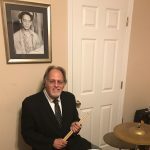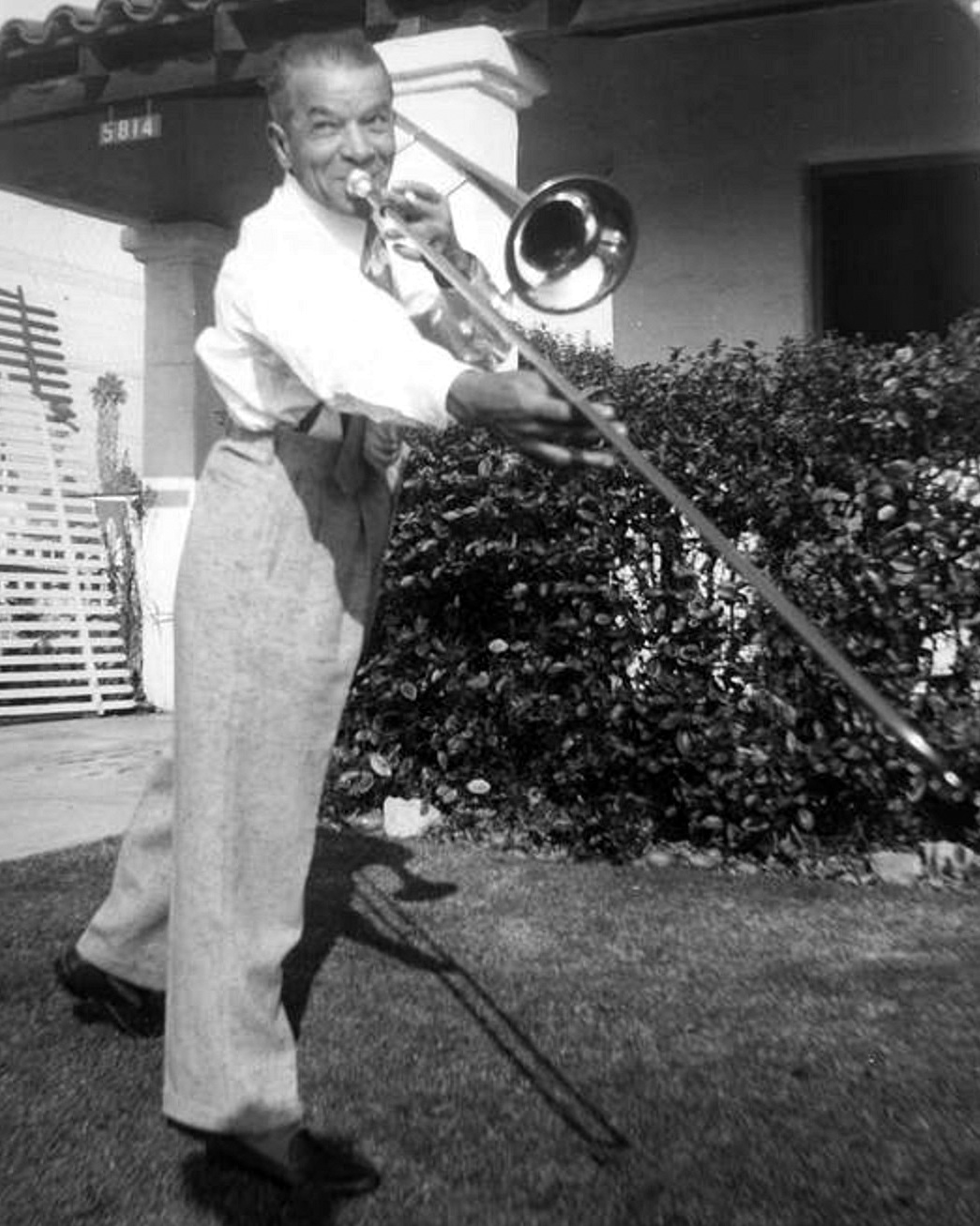
Jeff Barnhart: Hal, we’re beginning 2023 with a look at one of the most influential, colorful and exciting musicians in Jazz history; trombonist Edward “Kid” Ory! We’d originally planned on exploring his music later this year, but Tex Wyndham reminding me about the 1922 sides Ory was on in Los Angeles combined with your fortuitous (and excellently written) reminiscence in last month’s issue about hearing Ory, and Johnny St. Cyr in CA in 1965 (See: Yes! I Heard That Muskrat Ramblin’ Man!) to bump the Tailgate King to the frontline!
Ory was born on Christmas Day, 1886 in LaPlace, LA, about thirty miles west of New Orleans. In his teens, he led his own band in that small town before bringing it to NOLA around 1910. He stayed busy in the Crescent City, leading bands filled with other notable musicians in the teens, and finally headed west to Los Angeles in 1919; he never returned to New Orleans until he performed at the Jazz & Heritage Festival in 1971. Before we delve into the earliest recorded work of this jazz pioneer, would you share any special thoughts about this man, one of your favorite musicians?
Hal Smith: Well, Jeff, Kid Ory is my favorite trombonist—period. Ever since I heard him at Disneyland, then on the Good Time Jazz records, I have thought “That’s how a trombone is supposed to sound.” Also, I admire Ory’s rhythm section—particularly the 1953/1954 version with Don Ewell, Ed Garland and Minor Hall—above all others.
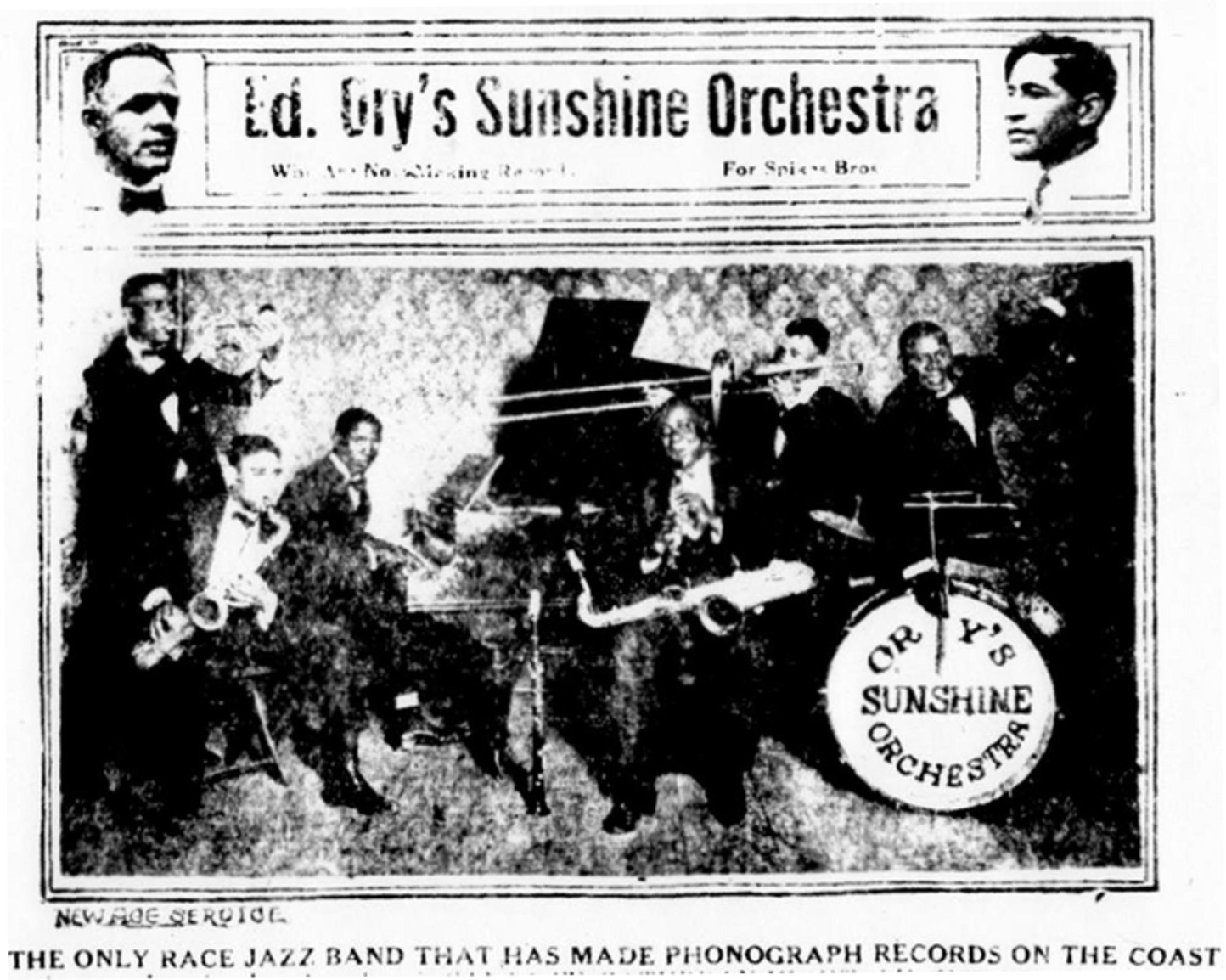
Borders (drums) – Courtesy Christer Fellers/The Kid Ory Archive
But going back to the beginning, let’s talk about Kid Ory’s first recording session…in the spring of 1922, the Spikes Brothers (Reb and John, co-composers of “Someday, Sweetheart”) talked Arne Nordskog into recording Ory’s band and vocalists Roberta Dudley and Ruth Lee at Nordskog’s studio in Santa Monica. The Spikes Bros. did a booming business selling recordings by Black artists and Ory’s band was a hot property up and down the West Coast.
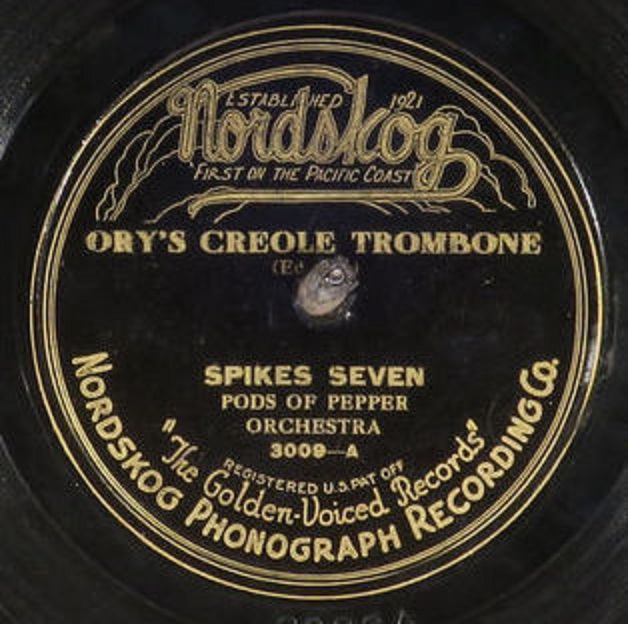
The Kid and his musicians took a train from Oakland to Los Angeles, minus Wade Whaley, the band’s regular clarinetist. Drummer and pianist Dink Johnson—Jelly Roll Morton’s brother-in-law—managed to teach himself to play clarinet before the session. Later, he recalled borrowing an instrument from the Spikes Bros. music store and copying the sound of Larry Shields on the Original Dixieland Jazz Band’s records! Despite the fact that Dink had not been playing clarinet very long, he sounds authoritative and very fluent on all the sides.
The repertoire for the session included the Spikes’ compositions “Society Blues,” “When You’re Alone Blues,” “That Sweet Something, Dear” and “Maybe Some Day” (later retitled “Some Rainy Day” and recorded by both Abe Lyman and Jimmie Noone). Dink Johnson contributed the serpentine melody of “Krooked Blues” and Ory was featured on his popular composition “Ory’s Creole Trombone.”
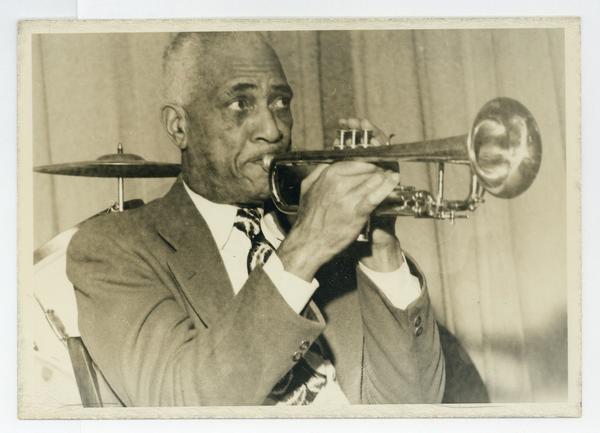 The musicians must have been trying to keep a straight face throughout the day every time they looked at Kid Ory. At a meeting with Nordskog the evening before the recording, Ory wondered aloud what he should wear to the session. One of the musicians (probably Mutt Carey) said “Tux!” Ory turned up at the studio attired in a tuxedo!
The musicians must have been trying to keep a straight face throughout the day every time they looked at Kid Ory. At a meeting with Nordskog the evening before the recording, Ory wondered aloud what he should wear to the session. One of the musicians (probably Mutt Carey) said “Tux!” Ory turned up at the studio attired in a tuxedo!
All jokes aside, the band did a fantastic job on this historic occasion. “Papa Mutt” Carey gives us an idea of how Freddie Keppard might have played if the Creole Band recording session had actually taken place four years earlier. Carey’s style still had traces of the Ragtime Era—particularly his phrasing. Dink Johnson played excellent clarinet parts in the ensembles. Fred Washington’s piano playing was very supportive, in the manner of Richard M. Jones. Drummer “Rhythm Ben” Borders played a lot of woodblock due to the acoustic limitations of the recording process, but nevertheless manages to make the rhythm move along. Bassist Ed Garland was inaudible until these recordings were released on Archeophone’s “Cabaret Echoes” CD.
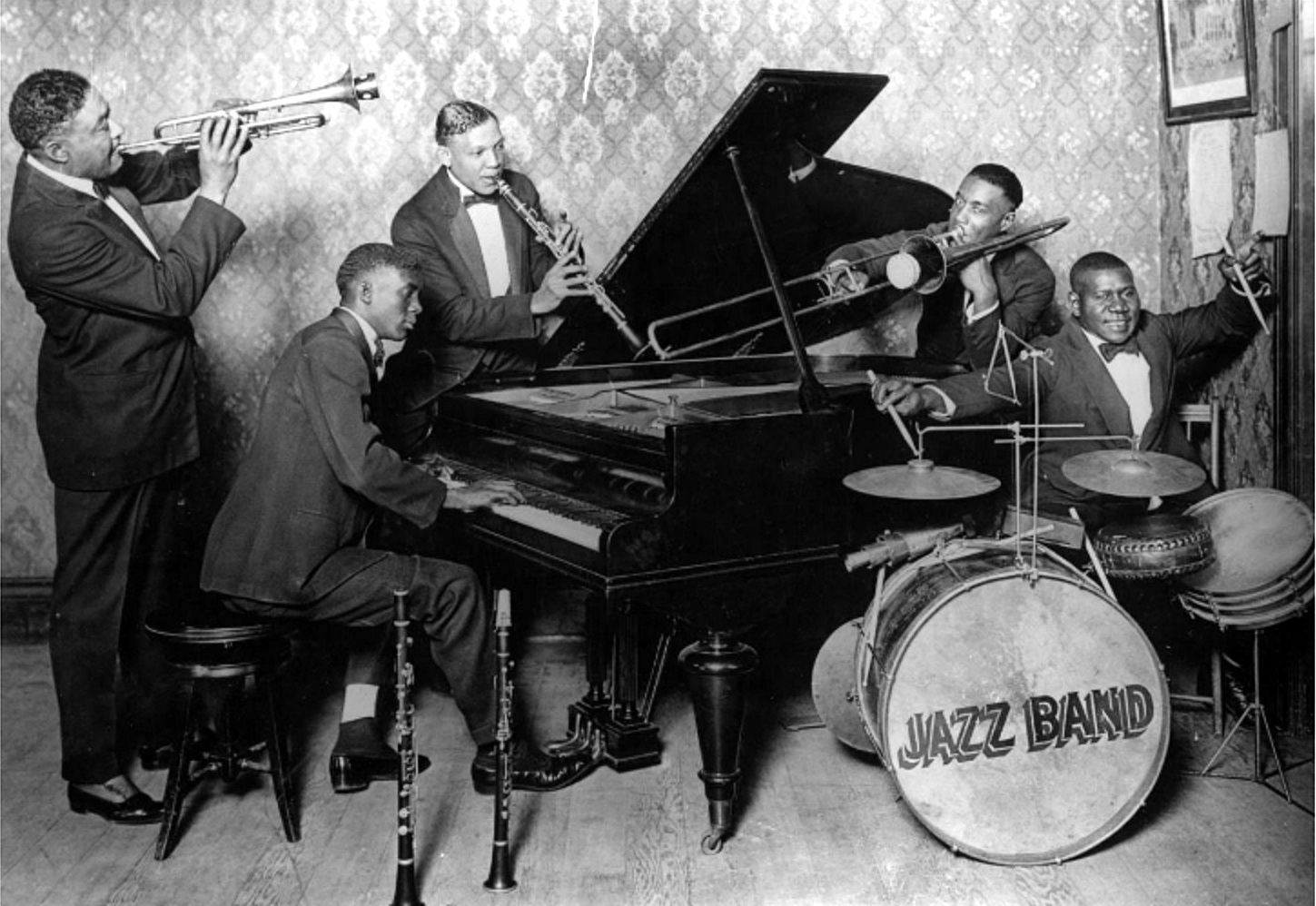
New Orleans Jazz Museum/Louisiana Digital Library
Using headphones to listen to the Nordskog sides, Ed Garland’s bowed bass is finally audible! And the sharply-dressed Kid Ory plays the same great slurs, smears, slides, and “putt-putt” lines that he continued to use for years. This recording session is definitely an auspicious start to Ory’s recording career. What are the highlights of this session for you, Jeff?
JB: Almost too many to outline, Hal! I love the image of Ory in that tux all day, especially when you factor in the reported start-time for the session of 8:00 in the morning!!
Some researchers suggest 1921 as the year of these recordings, based mainly on the recollection of Robert Nordskog, producer Arne’s son, but the general consensus at this point is 1922. Regardless of what year, Ory’s first recording session (as well as that of a black jazz band with musicians from New Orleans) comes in with a bang. In “Ory’s Creole Trombone” the Kid is, of course, the star, but Mutt Carey and Dink Johnson offer some hot playing, especially in the ensembles on the trio section, with phrasing only found in the players hailing from New Orleans—it’s incredible to me that Johnson had only recently picked up the clarinet. At this very early stage, even without the benefit of great sound, the two ensemble out choruses still quicken the pulse 100 years later!
“Society Blues” is a moderate blues (already pretty old with a copyright year of 1918) notable for the combination of freedom and arranged part-playing served up by the front line. While a bit derivative of the ODJB’s “Livery Stable Blues,” the music is hotter yet more relaxed; it’s simply better playing. It’s also remarkable for the 13-bar-length second section and the move up a step from F to G for the trio. This side is ensemble throughout excepting a couple of breaks by clarinetist Johnson (played over by pianist Fred Washington) and one each hot break by Carey than Ory (true solo breaks).
Regarding the sides by the two vocalists, I find the results uneven. The first warbler, Roberta Dudley, gets hot on her second vocal chorus on “Krooked Blues” but the real star of this side is the backing ensemble. After a brief intro and obligatory vamp, Dudley sings the verse and chorus, leading into an amazing 16-bar ensemble ride. The roadmap of this chorus is so involved, I had to listen several times, counting the measures, before it made sense to me; the first bar is three beats of unaccompanied Ory playing the motif heard throughout, with Johnson playing the fourth beat; second bar is an unaccompanied duet for Carey and Johnson; four bars of ensemble lead to a two-bar break for Carey (quoting “Peg of my Heart”!).
The second eight bars start the same as did the first but bars five and six are solo breaks for Carey, then Ory, into a final two bars ensemble. This snakey stop-and-go, combined with the off-kilter harmonies (everything sounds like it’s in the wrong place) makes for an iconoclastic performance—to top it off, the tune is in Gb!! VERY complicated—and exciting—stuff! It’s no wonder this one isn’t heard often (if at all) from contemporary groups; if it is, the band is referencing the instrumental version cut by King Oliver’s Creole Jazz Band in 1923.
Dudley and the group then assay “When You’re Alone Blues,” another tune that is not really the blues but is effective in its simplicity. Ory and Co. have little to do on this one so ’nuff said.
Singer Ruth Lee brings more vibrato and drama to her tunes. “Maybe Some Day” is typical early 1920’s material, highlighted two minutes in by a stomping, wailing half-chorus from the band. Carey takes a break to bring Lee back in and the tune wraps up with a lovely surprise coda by Carey and an ensemble button. “That Sweet Something, Dear” opens with an eight-bar ensemble intro and another vamp leading to Lee’s vocal of the verse and chorus—with some nice piano backing from Fred Washington—and the cornet/trombone tag would be fleshed out the following year for Oliver’s “Canal Street Blues.” The band really takes a back seat here so let’s move on.
Ory would record 10 sides as part of Louis Armstrong and his Hot Five for Okeh between November 1925 and February 1926. In April and May 1926, the Hot Five recorded four sides for the rival Vocalion label as Lillian Armstrong’s Serenaders and then as Lil’s Hot Shots and were back in the studio again in June for Okeh as the Hot Five.
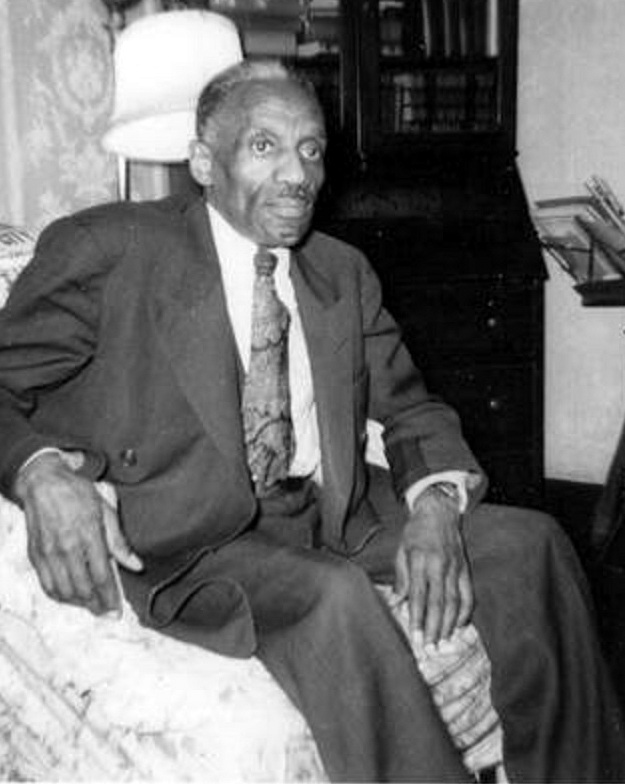
He also recorded during 1926 and 1927 with King Oliver and his Dixie Syncopators, as well as with Jelly Roll Morton’s Red Hot Peppers for Victor in 1926. The year 1927 found him several times in the studio with both the Hot Five and the Dixie Syncopators. Clearly, this man was in demand! Hal, we’ve already covered Oliver and Ory’s work with him in 1926 and 1927 (TST, September, 2022) and we’ll no doubt get around to listening to the Hot Five and Red Hot Peppers sides together, so let’s concentrate on Ory’s recordings with “one-off” ensembles from 1926 to 1928, all sessions producing stellar tunes by pioneering musicians boosted every step of the way by the giant of glissando!
HS: Before we do that, we should mention that those earliest recordings we’ve covered were made available on two different labels, under two different band names! Reb Spikes recalled, “For some reason, Nordskog put his labels on our records. He called Ory’s Sunshine Orchestra ‘The Seven Pods of Pepper’…We had contracted for 5,000 pressings that should have had our Sunshine label. We had to paste our label over his.”
While he was still working with King Oliver, Ory played on a 1926 session led by pianist Luis Russell. Russell, and reedmen Albert Nicholas and Barney Bigard were also playing in the Oliver ensemble at the time. The first tune they recorded, “29th and Dearborn,” was a composition by New Orleans pianist Richard M. Jones. It is actually an uptempo reworking of Jones’ “Riverside Blues,” which was co-written by “Georgia Tom” Dorsey. Note the interpolation of the cornet solos from “Chimes Blues” too.
This really is a hot record and it is reminiscent of the better Oliver sides from this period. Everyone gets a turn in the spotlight, even if it’s just a two-bar break. Cornetist George Mitchell, the only non-New Orleanian besides Russell, really shines with his clear tone and bouncy lead playing. Ory uses a mute, but the trombone solo leaves no doubt as to who is playing it!
“Sweet Mumtaz”—written by Russell—starts with trombone breaks; again, typical Ory phrases. On the trombone solo, following the reed duet, Ory plays a little busier than usual. But his chorus really moves things along! George Mitchell’s cornet solo prefigures the one he played on the New Orleans Wanderers’ “Perdido Street Blues” by about four months. Though I think “29th and Dearborn” is a hotter performance, “Sweet Mumtaz” still has plenty of get-up-and-go. What appeals to you on these two sides, Jeff?
JB: I dig the reed duet in “29th” executed by Bigard and Nicholas, two fantastic musicians playing together, not on-top of one another. George Mitchell’s solo could easily pass as a second cornet part to Oliver’s famous solo in “Chimes Blues” from three years prior. I also really enjoy hearing ensemble in between solos, so those two choruses separating Mitchell’s and Bigard’s rides stand out for me (I LOVE the four-horn front-line; dense but they never get in each other’s way!). On both sides for this session, you notice the indefatigable ingenuity of the band’s backing of each soloist—on “29th” Bigard gets a Charleston beat behind him, Ory’s chorus is backed by a latin-tinged rhythm and Nicholas gets stops on beats 1, 2 and 3. Did Russell have a hand in the arranging or were these put together “in house” with everyone brainstorming, do you think?
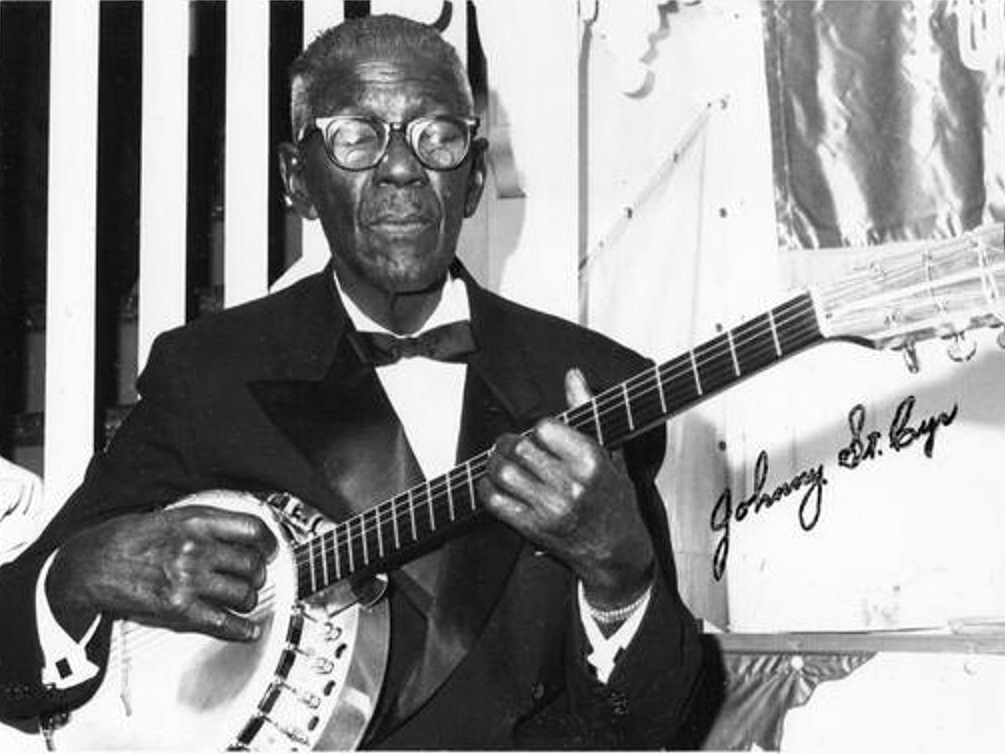
“Sweet Mumtaz” from the same date, though not as hot, is for me a far more interesting composition. A sinister, minor introduction is shared between ensemble and trombone breaks into the first 32-bar strain in D minor, Bigard playing the melody while the band executes a “Spanish snap” with the bridge changing to hot time. The second section remains in D minor; this 16-bar theme is first presented by a reed duet that could’ve been played by Jimmy Noone and Joe Poston. Ory takes over in a stomping chorus that starts with some “putt-putt” as you put it, before giving in to some righteous smearing! Nicholas on alto earns a vocal interjection by Jones, as does Mitchell (in a blistering solo!). Nicholas returns with a solo ending once again with Jones shouting (“Snag it!”) and Bigard romps through his solo with Jones urging the band to play hot for the final chorus. Jones’ interruptions aside, this piece remains one of my favorites from the mid-’20s and I wish more American groups played it (the tune is well represented with European and Scandinavian hot jazz outfits).
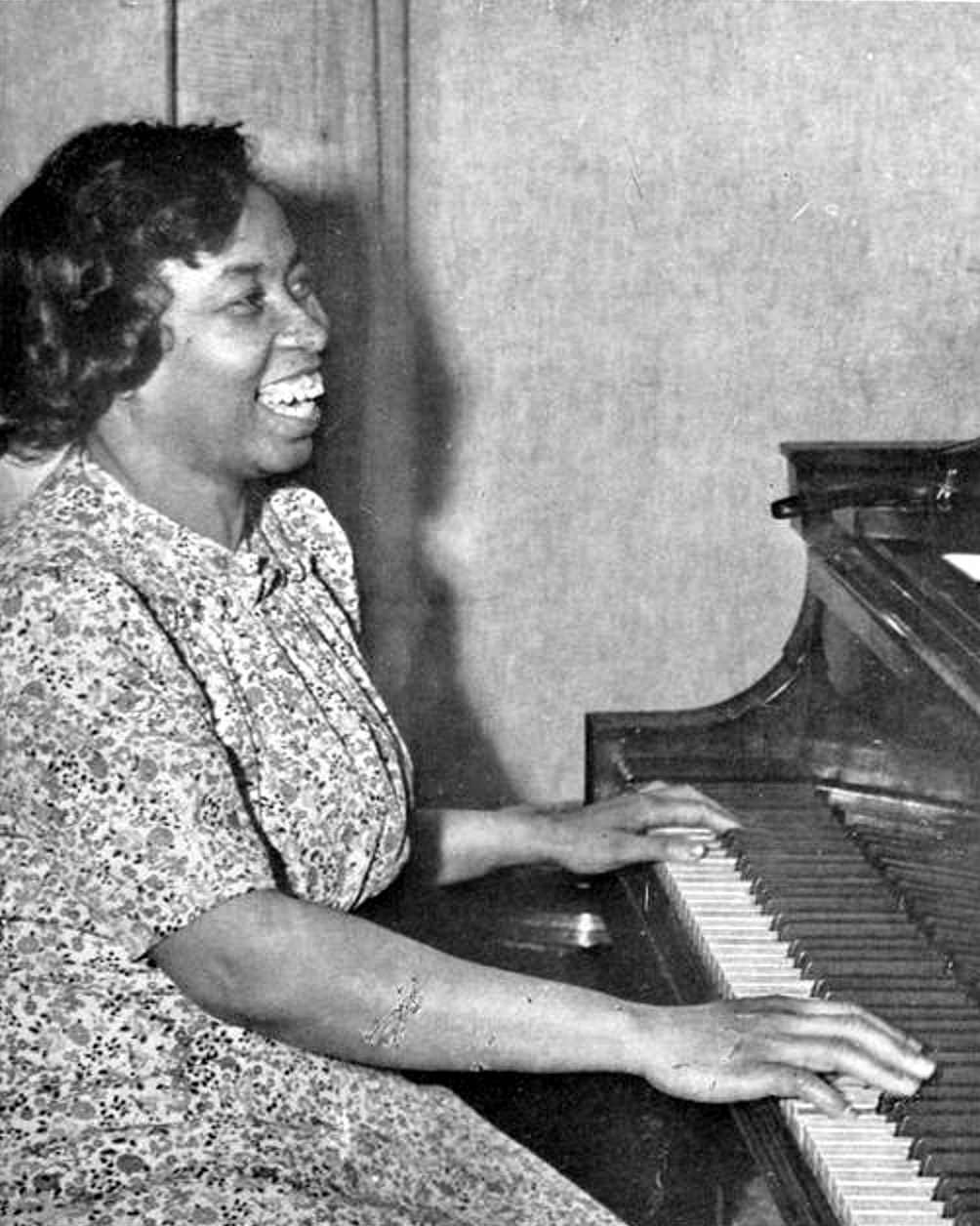
With the New Orleans Wanderers, Ory cut four incredible titles. The group was Armstrong’s Hot Five without Louis; they recorded these for Columbia and Okeh had Armstrong under contract. The positive here is that with Mitchell on cornet, the other players get more playing time and the whole thing feels more collaborative instead of four other musicians merely backing a demigod as often happened on the Hot Five sides led by Armstrong. Hal, where would you like to start?
HS: I agree with you that Mitchell’s cornet playing leaves more “breathing space” in the front line and the other horns have a little more opportunity to shine than on many of the Hot Fives. “Perdido Street Blues” is a masterpiece: Johnny Dodds’ searing clarinet breaks give way to Lil Armstrong and Johnny St. Cyr playing a no-nonsense vamp, then George Mitchell plays a minor-key solo which recalls the chorus he played on “Sweet Mumtaz” with Luis Russell a few months earlier. A modulation to F brings Dodds back to the forefront, wailing away over the first “bam-bou-la” rhythm and then cooling off a bit with some indigo clarinet. Solos by Lil, St. Cyr, and Ory (playing mostly whole notes) follow, before Mitchell leads the ensemble out. For the coda, Dodds repeats the clarinet-over-rhythm pattern for four more bars.
“Gatemouth” is a hot stomp from beginning to end. It is based on a traditional New Orleans song with an unprintable title, spruced up with a verse, breaks and stoptime rhythms. On this, and the rest of the Wanderers/Bootblacks sides, alto saxophonist Joe Clark was added. He was a fine player, but I will keep my comments regarding saxophone in a New Orleans band to myself! Even with the extra horn in the front line, Ory is everywhere throughout the side—playing wonderful licks and a fantastic sliding part over the last two choruses. Mitchell’s cornet break on the next-to-last chorus is often quoted by contemporary hornmen who play the song, as is the arranged break on the final chorus. Another “keeper!”
“Too Tight” seems to have disappeared from the classic jazz repertoire until the advent of Stomp Off Records in the late 1970s. Following a sinister-sounding minor verse, Johnny Dodds plays one of his best-ever solos. The vocal interjections are not credited, though I’m guessing it’s St. Cyr shouting the encouragement. Mitchell’s solo, with breaks by Ory, also sounds inspired. Dodds’ playing on the coda is a nice send-off.
“Papa Dip” was played in the key of F, rather than the more common key of Eb (probably because Turk Murphy’s 1949 recording of the piece influenced so many traditional bands). The soloists are Joe Clark and Lil (with breaks by Johnny Dodds). Ory’s slides are well-placed on both the verse and the chorus. I like hearing Mitchell use a mute later in the song, and the extra outchorus with a front line break. Before we move on to the second session by this band—renamed the “New Orleans Bootblacks”—what are your favorite parts of these four sides, Jeff?
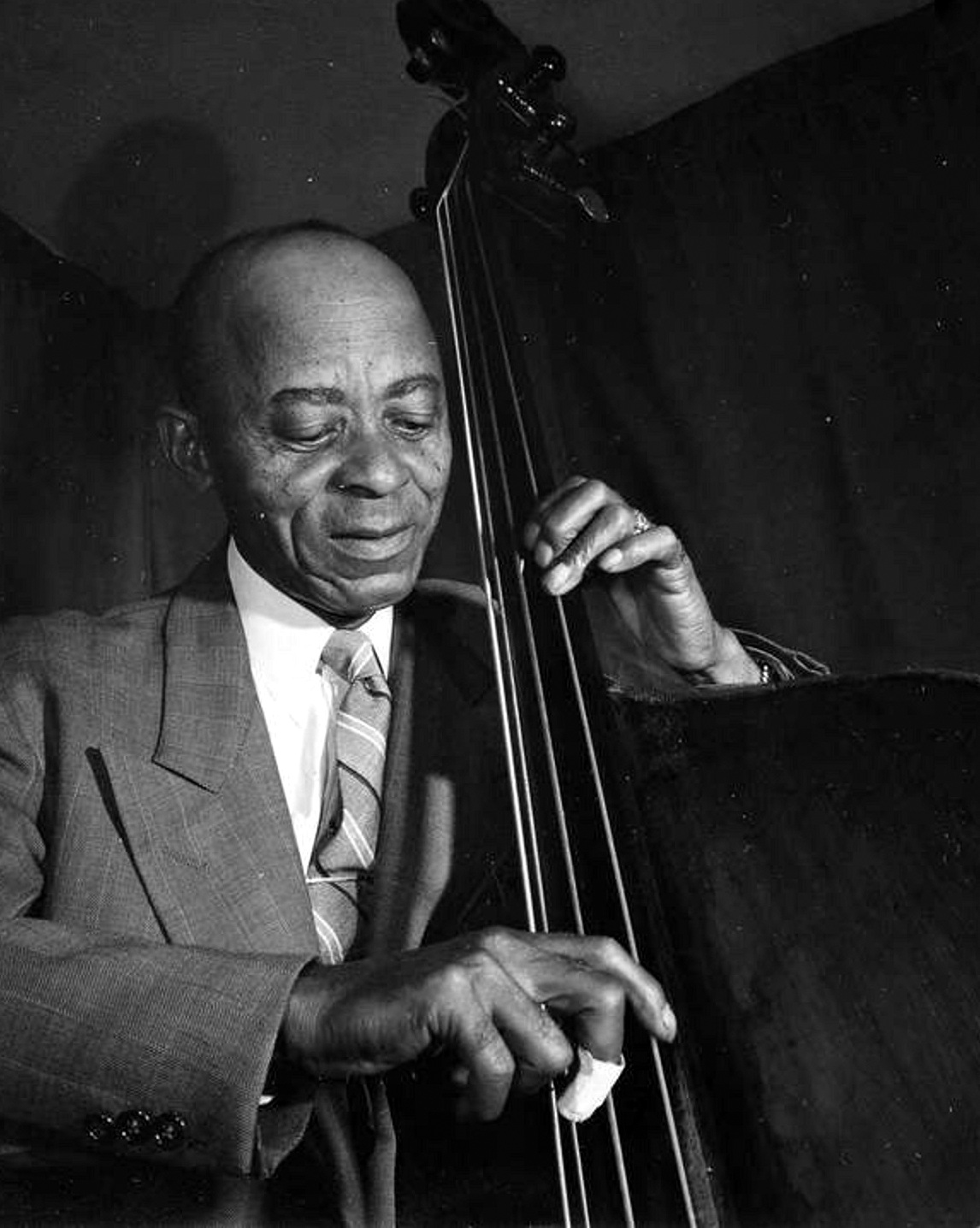
JB: Though he sounds great on “Perdido St.,” Mitchell’s solo is the only part of the tune I would’ve loved to hear Louis play! Regarding Dodds’ solo, I appreciate the dynamics you pointed out between choruses. The duo choruses between Lil Hardin and Johnny St. Cyr, each taking the lead with some boisterous backup from the other, is a real highlight for me. Ory’s sliding chorus is now iconic and copied by ’bonists the world over.
For me, the addition of alto saxophonist Joe Clark to the next three cuts is a step-up regarding the overall sound of the band! “Gatemouth,” with its almost constant ensemble, is the highlight! Dodds gets some stops for ¾ of a chorus and then it’s two ensembles with breaks for St. Cyr and Ory, a solo chorus for Clark with inventive backing from the band and then 2 out choruses with breaks for Mitchell and a four-horn break that, as you pointed out, is still de rigueur 96 years later!
“Too Tight” is a solo grind, starting with a Cm verse and leading into a 16-bar chorus in Eb, with great solos by Dodds and Mitchell and some hot breaks (the ones Ory takes on Mitchell’s solo show how much he influenced Turk Murphy!). Loose, relaxed, in the groove, like all the sides from this date, this one’s a keeper!
I groove on “Papa Dip” for the tight ensemble with fine solos by Clark and Hardin. After the solos it’s back to ensemble verse and three choruses out! Breathtaking! While I adore Armstrong (what’s not to love?) I’m glad four more sides were recorded by this line-up the next day as the New Orleans Bootblacks. Regardless of the name, this is an outfit where everyone gets to shine!
We’ve run out of room this time around. Anything else to mention before we wrap up, Hal?
HS: We need to credit author John McCusker for his book Creole Trombone (University of Mississippi Press, 2012) and British trombonist Sid Bailey’s self-published Ory discography called The Greatest Slideman Ever Born. Sid generously made the content available on Christer Fellers’ website “The Kid From LaPlace – The Kid Ory Archive.” That website—and the two books—are invaluable resources for researching Kid Ory’s life and his music.
JB: Indeed, and these will help inform us as we move forward into part two of our celebration of all things Ory! We’ll start with the New Orleans Bootblacks and then launch into other great sounds with stellar ensembles, all anchored, augmented, and urged by the one and only Edward “Kid” Ory!
Jeff Barnhart is an internationally renowned pianist, vocalist, arranger, bandleader, recording artist, ASCAP composer, educator and entertainer. Visit him online atwww.jeffbarnhart.com. Email: Mysticrag@aol.com
Hal Smith is an Arkansas-based drummer and writer. He leads the El Dorado Jazz Band and the
Mortonia Seven and works with a variety of jazz and swing bands. Visit him online at
halsmithmusic.com






